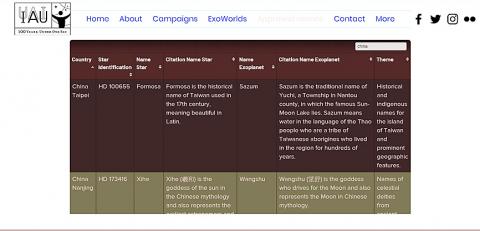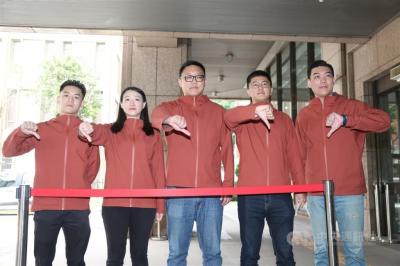Taiwanese astronomers who named an exoplanet and the star it orbits have been listed as being from “China Taipei” by the Paris-based International Astronomical Union (IAU), the Astronomical Society of the Republic of China (ASROC) said on Friday.
The astronomers, who were part of a research team that last year became the first to photograph a black hole, were invited by the IAU to an event to mark the group’s 100th anniversary and name recently discovered exoplanets and their stars, but attended under the title “China Taipei,” the society said.
The IAU said the designation was the result of discussions it held in 1979 with Chinese authorities, which concluded with Chinese astronomers working under the title “China Nanjing” and Taiwanese astronomers as “China Taipei.”

Photo taken from the International Astronomical Union Web site
After it announced its intent to participate in the event and opened up entries to Taiwanese astronomers, ASROC received 128 submissions, which received 6,101 votes, it said, adding that it chose the winning entry last month.
The winning name for the star HD 100655, a giant yellow star in the Leo constellation, was “Formosa,” the old Portuguese name for Taiwan, which means “beautiful,” it said.
The star’s exoplanet was named “Sazum,” the traditional name of Yuchi Township (魚池) in Nantou County, which means “water” in the language of the Thao people, “who lived in the region for hundreds of years,” it said.
Academia Sinica Institute of Astronomy and Astrophysics director Chu You-hua (朱有花) said this was the first time Taiwanese astronomers had named an exoplanet, and it was a proud moment for Taiwanese that the nation’s name could spread to the far reaches of the universe.
Recounting the history of Taiwan’s title at the IAU, Chu said the Republic of China joined it in 1935, but after China joined in 1959 as the People’s of Republic of China conflicts arose over two “China” member countries within the organization.
China demanded that Taiwan not be allowed membership, and had threatened to leave if it remained, the IAU said, adding that in the 1979 discussions, China said it was resolutely opposed to any references to “two Chinas,” or to “one China, and one Taiwan.”
The IAU implemented the naming scheme in 1982, Chu said.
“This name we are listed as now was hard won, and affords Taiwanese astronomers a legal basis for participation,” she said, stressing that on the IAU’s Web site, Taiwan is placed under the category titled “national members.”

Taiwan is stepping up plans to create self-sufficient supply chains for combat drones and increase foreign orders from the US to counter China’s numerical superiority, a defense official said on Saturday. Commenting on condition of anonymity, the official said the nation’s armed forces are in agreement with US Admiral Samuel Paparo’s assessment that Taiwan’s military must be prepared to turn the nation’s waters into a “hellscape” for the Chinese People’s Liberation Army (PLA). Paparo, the commander of the US Indo-Pacific Command, reiterated the concept during a Congressional hearing in Washington on Wednesday. He first coined the term in a security conference last

Prosecutors today declined to say who was questioned regarding alleged forgery on petitions to recall Democratic Progressive Party (DPP) legislators, after Chinese-language media earlier reported that members of the Chinese Nationalist Party (KMT) Youth League were brought in for questioning. The Ministry of Justice Investigation Bureau confirmed that two people had been questioned, but did not disclose any further information about the ongoing investigation. KMT Youth League members Lee Hsiao-liang (李孝亮) and Liu Szu-yin (劉思吟) — who are leading the effort to recall DPP caucus chief executive Rosalia Wu (吳思瑤) and Legislator Wu Pei-yi (吳沛憶) — both posted on Facebook saying: “I

The Ministry of Economic Affairs has fined Taobao NT$1.2 million (US$36,912) for advertisements that exceed its approved business scope, requiring the Chinese e-commerce platform to make corrections in the first half of this year or its license may be revoked. Lawmakers have called for stricter enforcement of Chinese e-commerce platforms and measures to prevent China from laundering its goods through Taiwan in response to US President Donald Trump’s heavy tariffs on China. The Legislative Yuan’s Finance Committee met today to discuss policies to prevent China from dumping goods in Taiwan, inviting government agencies to report. Democratic Progressive Party Legislator Kuo Kuo-wen (郭國文) said

The Ministry of Economic Affairs has fined Taobao NT$1.2 million (US$36,900) for advertisements that exceeded its approved business scope and ordered the Chinese e-commerce platform to make corrections in the first half of this year or its license would be revoked. Lawmakers have called for stricter supervision of Chinese e-commerce platforms and more stringent measures to prevent China from laundering its goods through Taiwan as US President Donald Trump’s administration cracks down on origin laundering. The legislature’s Finance Committee yesterday met to discuss policies to prevent China from dumping goods in Taiwan, inviting government agencies to report on the matter. Democratic Progressive Party